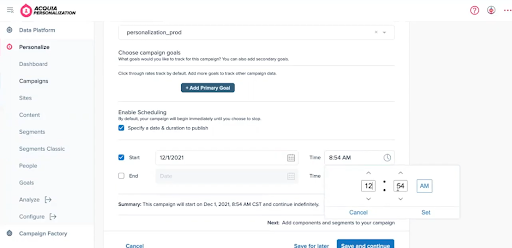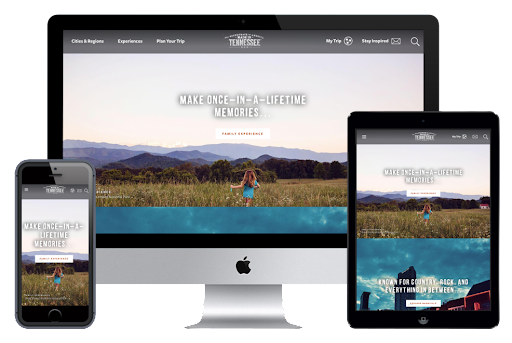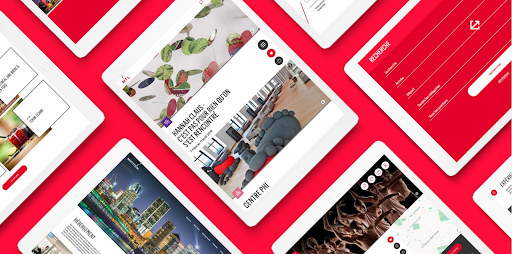Personalization – a buzzword that’s been gaining currency in marketing circles for about a decade – is as old as commerce itself.
Readers of a certain age will remember when the video store clerk knew your name, had your favourite snack on standby, and didn’t give you side-eye when you rented Dirty Dancing for the 12th time. That’s the “OG” personalization. And it’s a major reason why brick-and-mortar retail continues to outperform ecommerce by a significant margin even in the post-COVID world.
For digital marketers, personalization is the new holy grail. The global personalization software market is expected to exceed $1 billion USD for the first time this year, and is projected to reach nearly $5.2 billion by 2030. This growth has been made possible by an influx of machine learning technologies, which are creating more intelligent, automated, and actionable software platforms.
Digital personalization may be relatively new, but people have quickly come to expect it—especially since the pandemic-era surge in ecommerce. Market research now shows that personalized communications are a major factor in brand consideration. Over three quarters of consumers say that personalized content makes them more likely to repurchase from a particular brand.

Acquia Personalization dashboard (source: Acquia)
What is Digital Personalization?
Digital personalization is when an organization fine-tunes an online experience for individual users based on information that it has learned about them. Things like:
- User persona (age, gender, occupation, place of residence etc.)
- Geolocation
- Source (e.g. Google search, email, social media, paid ads, referring site)
- Browser or device type
- Company information (for B2B interactions)
- Time of day
- Visit frequency and browsing behaviour
- Purchase history
- Mouse movement (scrolling, hovering, inactivity)
Channels that can be personalized include websites, mobile apps, emails, web apps (including SaaS applications), online ads, and online chats.
Personalization vs. Customization – What’s the Difference?
Customization is when a user adapts an experience to their own needs and desires. Personalization is when the platform owner anticipates a user’s needs and tailors the experience for them.
Think about it like this:
Customization is that stand in the cafe where you add sugar, sweetener, or cinnamon to your coffee. Personalization is the barista preparing your favourite coffee as soon as you walk in without you having to say a thing.
A digital example:
Customization is Googling for coffee beans, hunting for a brand that aligns with your tastes, ethical practices and price point, adding it to your cart, filing in your credit card information and getting it delivered.
Personalization is a coffee brand sponsoring a paid ad on Facebook, knowing that you’re a female Millennial between ages 24 and 34, lives in Toronto, is a coffee snob who wants only the finest Ethiopian ethically fair-trade beans, auto-fills your information in checkout, and makes purchasing happen in three clicks.
There is clearly widespread appetite for a personalized web experience. But by overdoing it, you risk projecting a dystopian “big brother” image that’s off-putting to users. This is where personalization converges with customization—users should always have control over what data they provide and what it can be used for.
It’s also worth noting the importance of using customization to make digital experiences accessible for users with disabilities.
How Does Digital Personalization Work?
While 96% of marketers say that personalization helps advance relationships with customers, only 30% report feeling very or extremely satisfied with their own efforts in this area. Fortunately, there are steps you can take to provide a fine-tuned, personalized digital experience.
Step 1: Create a Unified Customer Profile
Even if a visitor to your site is anonymous (as the vast majority are), they still provide valuable information that you can start a user profile with. You can ascertain their source on the web, their geographic location, and what device they’re using. This is foundational information for a user profile that can further be expanded on every time they come back to your site.
Ideally, the user will eventually respond to a call to action or engage with you via social media. At this point you can merge this new “known profile” with the anonymous one that’s already been created, giving you a nuanced picture of the user that can be used in subsequent marketing initiatives.
Step 2: Establish an Omnichannel Marketing Strategy
Today’s audiences want to interact with brands across a wide range of devices and touchpoints—including social media, newsletters, direct emails, mobile apps—and expect a personalized experience across all channels. In order to provide a personalized experience, you need to be on the same channels as your audience and start personalizing accordingly.
Learn more about how to manage your Content Smarter (Not Harder) with DAM.
Step 3: Conduct A/B and M/V Testing
A/B testing is the process of testing multiple versions of a single variable (e.g. the position of a banner or button) to see what people prefer. It’s also called split testing, bucket testing, or – when a third variable is introduced—A/B testing.
A/B testing is a valuable undertaking in the personalization process. It enables you to find out what types of content and layout people respond more positively to, and who responds positively to what.
A counterpart to A/B testing is M/V (or multivariate) testing, in which multiple tweaks are tested simultaneously. M/V testing allows you to test multiple factors at once, so it’s preferable for minor changes and for testing pages with very high traffic volumes or conversions. A/B testing is generally recommended for more major changes and for pages with under 100,000 unique views per month. Those wanting to milk a site for every drop of data possible for personalization will want to do both.
What are visitors engaging with? What are they clicking on? The only way to find out is to provide alternatives and gather data. The most successful companies out there conduct these types of tests all the time, and as this Harvard Business Review article points out, even the tiniest of modifications can yield impressive results.

The Tennessee Department of Tourism Development website (source: Acquia)
Step 4: Engage in Behavioural Targeting
Successful personalization involves segmenting audiences into as many different categories as possible. While demographic data and geolocation are useful categories, it is equally important (if not more so) to be able to group users by how they interact with your digital tools—data that the above-mentioned A/B and M/V testing will hopefully provide.
Once you have a fine-grained understanding of users’ online behaviour, you can then segment your audience into behavioural categories and target users accordingly. With behavioural targeting, you can personalize your marketing efforts based on numerous data sources, including:
- What people are looking at and clicking on in your site
- Which emails are people most likely to open
- What items people are purchasing, adding to their cart, or simply looking at
- What actions people have taken on your app
Behavioural targeting is most closely associated with e-tailers like Amazon, who personalize for customers based on their purchase and search history. But many other organizations are using this tactic, with impressive results. For example, the Tennessee Department of Tourism Development managed to decrease its site's bounce rate by 19% while increasing its average session duration by 29%. They did this by leveraging Acquia Lift to personalize user experience based on a users’ search patterns related to specific destinations.

The Tourisme Montréal website (source: Cossette)
Step 5: Automate
Once you’ve sliced and diced your user data into overlapping segments and created content to match, it’s time to deliver that content. This is where automation becomes essential for providing a true 1:1 online experience. It allows you to leverage complex algorithms that deliver your optimized content to the people most interested in it.
An example of this in action is the Tourisme Montréal website. In collaboration with the marketing firm Cossette, Tourisme Montréal created a website that features a proprietary recommendation engine. This delivers real-time personalized content to site visitors by way of machine learning. It also delivers content recommendations for email communications for every user.
The results? As of April 2018 the recommendation engine had delivered close to 3 million content impressions in a short period following the site’s soft launch. What’s more, it reduced the site’s bounce rate by 30%, indicating a much higher degree of user satisfaction.
Common Barriers to Personalizing Content
Personalization may be a simple enough concept, but implementing it is easier said than done. A 2020 Gartner survey of marketers showed that two-thirds (63%) continued to struggle with delivering personalized experiences, while only 17% were leveraging artificial intelligence and machine learning for this purpose.
One reason for this is that most of the personalization technology on the market today is challenging to implement. The majority of marketing teams lack the in-house expertise to properly leverage it, forcing them to rely on typically overstretched IT teams.
Additionally, many marketers struggle to access the data they need for personalization. This is often due to sites built on closed source proprietary platforms, which tend to silo their user data outside the marketing stack.
How Acquia’s Personalization Can Help
Acquia’s cloud-based Digital Personalization Software, coupled with the open source model of Drupal, makes personalization as easy as it possibly can be.
A no-code platform geared for Drupal, Acquia Personalization requires no IT support. Marketers with little to no technical experience can quickly get to work with easy-to-use point-and-click tools. The platform supports a simple three-step process (testing, targeting and experience creation) that enables marketing teams to deliver personalized content in a matter of milliseconds.
Acquia Personalization has machine learning capabilities out-of-the-box, meaning that you don’t need a data science team to deliver a truly 1:1 online experience. You can use the software on any Drupal site (regardless of whether it’s hosted by Acquia), or on a non-Drupal site by configuring environment variables.
Acquia Personalization consists of three main components:
- Profile Manager: This is where a unique profile is created when a user first visits the site. It aggregates as they visit more content, gradually creating a nuanced, fully fleshed-out profile spanning multiple segmentation categories.
- Campaign Builder: This is where marketers create campaign experiences, select their audiences, and create "slots" on pages where default content is replaced with personalized content.
- Content Hub: This is the central location where content is made available to marketers, from which it is funneled to selected audiences
Notable features of Acquia Personalization include:
- Unified visitor profiles
- Real-time segmentation
- Content syndication
- Built-in A/B/n testing
- A powerful analytics engine
- Data collection including: geolocation, online source, device type, visit frequency, browsing behaviour, pages viewed, completed events, CRM integration, cross-channel behaviour, and any combination of these
Personalization is challenging, but it doesn’t need to be out of your reach. Acquia provides both the sophisticated digital suite and the all-encompassing customer support to help you get started. Sign up for instant access to the tool or contact Acquia to request a demo.
Need digital marketing support?
The brilliant thing about Acquia Personalization is that you don’t need an IT team to support you—you can just get started personalizing your digital presence on your own. However, when it comes to incorporating personalization into a broader marketing strategy, many teams will need outside support.
Evolving Web’s marketing team has the expertise needed to guide you to a more personalized brand presence.

